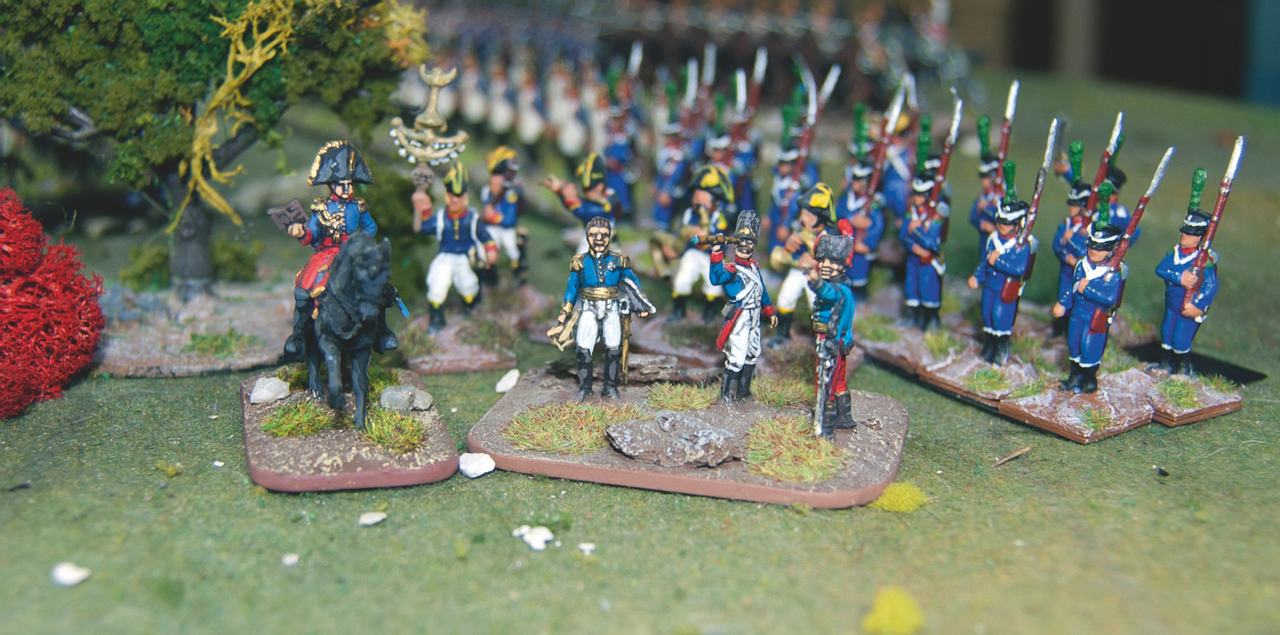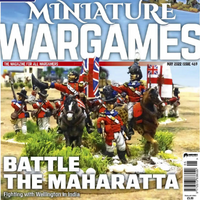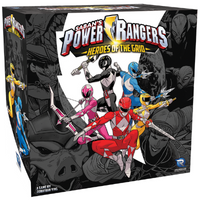01 February 2022
|
A Scenario for Command & Colours: Napoleonics
Words by Conrad Kinch
The battle of Cardedeu isn’t one that immediately leaps to mind when thinking of the Peninsula War. That is probably in no small part to the fact that it is an entirely Franco-Spanish affair with no British troops involved, which is always a recipe for obscurity in the English speaking world.
It is one of the tragedies of the historiography of the Peninsula war that so often the Spanish end up as bit players in their own drama. I think, to an extent, that a lot of that is due to the fact that people like the ‘big show’: the drama of the pitched battle and we zero in on that. This understandably focuses attention on Salamanca, Vitoria, Talavera, et al but ignores the huge contribution played by the Spanish in their own liberation.
To paraphrase John Milton, they also serve who stand and wait and maintain an army in being, despite repeated defeats in the field, only to die, rally and rise once again to face the foe. That’s probably not going to make a stellar ending to a sonnet, but it’s a pretty good summary of the Spanish experience in the Peninsula War: often beaten, they were, however, dogged and unrelenting.
Which brings us to our battle: I came across this in David Gate’s excellent book The Spanish Ulcer, but you’ll find further details in Oman and Colonel Liscombe’s Atlas. As always, I will try to keep the potted history short, as Wikipedia will give you the highlights.
BACKGROUND
December 1808
After failing to take Gerona in August 1808, General Duhesme found himself in a bit of a pickle. Not only were Spanish Somatenes harassing his rear, but the Royal Navy was attacking his men on the coast roads. Badgered and beset on all sides, he destroyed his guns and heavy equipment and fell back to Barcelona, where he was promptly stuck.
This presented the Spaniards with the possibility of recreating Bailen, capturing another French army, and setting church bells ringing across the continent.
This would have rather put a spoke in General Bonaparte’s wheel and he sent more men led by General Saint Cyr to put his stamp on Catalonia. Saint Cyr moved with typical determination and invested the fortress at Rosas, which was held by a motley assortment of Spaniards and Royal Navy personnel. This was swiftly taken and Saint Cyr marched on Gerona with 17,000 troops. Gerona was a far more forbidding prospect and Saint Cyr realised that he had not the force to take it in time to relieve Barcelona, whereupon he made a characteristically bold decision.
Saint Cyr sent his baggage and guns to the rear and bypassed Gerona, marching over mountain tracks and making for Barcelona. This forced march took the officer tasked with reducing Duhesme, General Vives, quite by surprise. He had been taking his time over the siege and does not seem to have considered the threat with due seriousness. Vives detached General Reddings Division and dispatched them to intercept Saint Cyr near Cardedeu.

ENGAGEMENT
The Spanish forces were deployed on a steep wooded ridge in the Besos valley. Saint Cyr understood that troops had been sent from Gerona to attack him and was acutely aware that his army had only the food, supplies and ammunition that it had in its knapsacks. He settled on a plan which put his faith in the strength of French arms and the comparative weakness of Spanish infantry. He formed his men into one giant column and charged – bald headed – at the Spanish positions.
It was a high stakes gamble predicated on the fact that his men had no supporting artillery and did not have the ammunition required for a long fight. Saint Cyr bargained that – by relying on a bayonet assault on a narrow front – he would prevail. He was almost proved wrong when the officer commanding the head of the column, General Pino, disobeyed orders and began to deploy his men rather than descending on the Spaniards in a rush. This initial attack was repulsed until Saint Cyr took personal command and led the column on, so that the Spanish line was breached. The Spaniards fled and were ridden down by the French cavalry, losing 2,500 men.
The French marched on and then entered Barcelona on the 17th December. General Duhesme rather churlishly tried to maintain that his position had not been as precarious as all that, until Saint Cyr replied by handing the man one of his own despatches pleading for relief.
WRITING THE GAME
In the writing of this scenario I’ve had to struggle with two particular conundrums, firstly the sources differ on exactly how many men Vives sent to intercept Saint Cyr. David Gates reports that he had about 8-9,000 infantry, approximately 600 cavalry and half a dozen guns, while other sources, like Liscombe, report a more substantial force of 14,000 men. Given the fact that Spanish troops are awful in Command & Colours Napoleonics (herein C&CN) and that I am determined to make a game of it, I have plumped for the larger figure.
Secondly, the Spanish general has a ticklish problem on his hands. He has the smaller force; his troops are less experienced and contain a high proportion of raw recruits. The French player could quite easily brush him aside contemptuously. With that in mind, I have pitched the victory conditions in such a way that it is not strictly necessary for the Spanish player to win a pitched battle. He can win if he delays Saint Cyr sufficiently that the forces from Gerona could catch him or if he manages to maintain sufficient of his force in good order to remain a threat.
ORDER OF BATTLE
Spanish: Vives
Total: 9000 regulars, 5000 guerillas
Left Wing: Vives
Granaderos Provincales de Castilia la Nueva (2)
Soria(2)
2nd Almeira
Voluntararios de Tarragona
2nd Tercio de Miqueletes de Vich
Tercio de Miqueletes de Valles
Hussars Espanoles (2 squadrons)
6 guns
Right Wing: Reding
1st Baza
Voluntarios de Palmas
3rd Suizo Reding
Castilla la Vieja (2 Battalions)
1st Tercio de Miqueletes de Vich
Tercio de Miqueletes de Igualada
Hussars of Granada (3 squadrons)
7 guns
Milans Irregulars
Tercio de Miqueletes de Lerida
Tercio de Miqueletes de Manresa
Tercio de Miqueletes de Granollers
French: Saint Cyr
Total: 16,500 men
Souham
1ieme Leger (2 battalions)
3ieme Leger (2 battalions)
7ieme Ligne (2 battalions)
42ieme Ligne (2 battalions)
67ieme Ligne (2 battalions)
Pino
2ieme Italian Leger (3)
6ieme Italian Ligne (3)
1ieme Italian Leger (3)
4ieme Italian Ligne (3)
7ieme Italian Ligne
Chabot
2ieme Neapoltian Ligne
(2 battalions)
Chasseurs Pyrenees-Orientales
(2 battalions)
24ieme Dragoons (2 squadrons)
Italian-Dragoons Napoleon
(2 squadrons)
Italian Royal Chasseurs
(2 squadrons)
Note: This is based on Liscombe (p85), who lists his source as a Spanish army official history published in 1822. It is included should you wish to convert the scenario to your own ruleset. As C&CN does not have a set unit-to-man scale, I have nipped and tucked the order of battle to get it to work and have exaggerated certain aspects to make for a more interesting game.

BATTLE NOTES
French
Commander: Juan Miguel de Vives
5 cards.
Spanish
Commander: Laurent Gouvion Saint-Cyr
4 cards, move first.
Optional Tactics cards (if using Exp.5 Marshalls & Tacticians): Spanish 4 Tactician cards, French 5 Tactician cards.
Victory: 6 Banners
SPECIAL RULES
Do not shuffle the deck when Elan is played. If the French have not won by the time the deck has run out, the Spanish player wins.
The French forces are racing against time. The Spanish player, when playing a Scout command card, may take a Victory Banner and draw only one command card, as an alternative to drawing two command cards. This can be done up to three times during the game, however it cannot be done in successive turns and it cannot be the final winning Victory Banner. To give an example, a Spanish player who has two Scout cards in hand cannot play them one after the other in order to score to two easy victory points. Spread them out!
The Victory Banner in the Spanish back line leads to the bridge across the Rio Canoues and is a temporary Victory Banner for whichever side holds it. The French player must hold that Victory Banner to claim victory.
Pinos Division are Italian rather than French. While good troops, they got themselves into trouble early on in the engagement and are rated as French Line, but do not receive the +1 bonus in melee combat.
The 2ieme Neapolitan Line are rated as militia.
The River Magent is only crossable at the bridge, the River Fou is fordable.

MINIATURES
I used standard 1/72 Peninsular war armies for this game. The Italians of Pino’s Division were dressed in uniforms that were basically French in cut, but in white. I didn’t have anything like that, so I distinguished between French infantry and Italian infantry by using lads in greatcoats for the Italians. My Neapolitans were in pink facings rather than the more correct red because that’s what I happened to have.
One unit that caught my eye when I should have been doing other things was the Chasseurs Pyrenees-Orientales. They were a unit of border guards made up of poachers, smugglers and other assorted waifs and strays. They were recruited to guard the border on the understanding that they would not be used outside of France, but that became just another one of Bonaparte’s broken promises and they were deployed to Spain. They seem to have worn the standard French light infantry uniform, but in brown rather than blue: they might add a little variation to a French peninsular army. I may have to paint up a unit.
The Spanish were a mix. I used guerillas to represent Milan’s irregulars and saved my uniformed figures for the Spanish line. I’m lucky enough to have Swiss in Spanish service painted, so I used those, but I would advise you not to get hung up on the uniforms and make do with whatever Spanish troops you have to hand.
The key point is to make sure that you and your opponent know what represents what. Clarity on the tabletop is the main thing.
TERRAIN
I used my standard Spanish terrain for this game. In converting the map, I mostly relied on Liscombe, rather than Gates as the Gates map is really more of a schematic than anything else. The battle took place in the bottom of a valley with rivers flowing down and across it. The main Spanish position was on a spur in front of the river Fou. The sides of the valley – at least as far as I can see from Google Maps – aren’t particularly steep, though they’d certainly be enough to channel an axis of advance: however they were (as they still seem to be now) fairly thickly forested. Under the circumstances, I reckoned using woods to break up the terrain on the northern flank and provide the Spanish Lights with some cover seemed the best course of action. I only actually have one set of river tiles, so I used a light dusting of kitty litter to distinguish between the fordable River Fou and the deeper River Margent.

PLAYING THE GAME
I’ve played this scenario five times in various incarnations, using the solitaire rules released by Steven Malecek and very good they are too. You will find them here on line. I’ve only played as the Spanish and to be honest, the first two games were more historical than fun, with the Spanish getting absolutely whipped. The French players job is relatively simple, go for the Spanish with the bayonet. The trick is in working out where to go for him and when to unleash your cavalry. The Spanish troops are (with the exception of the Swiss) uniformly worse than their French counterparts.
Winning as the Spanish requires the defending player to use his guns as much as possible, make good use of retreats to remove battered units from the firing line before they can be destroyed and run the card deck when he can to get to those Scout cards. It is unlikely, unless the French player is extremely dilatory, that the Spanish player will be able to win by running out the card deck. I chalked up two victories as the Spanish and they were both close with me teetering on the edge of loss (mainly after the slaughter of Milans militia men), but with the French unable to reach the required Victory Banner in my rear before I could pile on enough casualties to break their army.
LINKS & BIBLIOGRAPHY
The Spanish Ulcer by David Gates A good all round history of the Peninsula. Lacks the brio of Weller or the depth of Oman, but a good overview.
The Peninsular War Atlas by Colonel Nick Liscombe. A great book that combines the single volume history and the atlas into one volume. Pricey, but definitely worth it.
Learning Objectives by Jon Sutherland (published in Battlegames). A must read for anyone planning asymmetric wargames.
To Assure My Dynasty by David Ensteness. This is a campaign guide for 1808 for the Et Sans Resultat! ruleset and was a very kind gift from my pal Reverend Micheal Peterson. It’s basically a collection of scenarios and gave me some ideas about how I might approach the battle, but it must be said the collection of uniform plates in the back for literally every formation you can think of is invaluable.
Solitaire rules for C&CN by Steven Malecek
If you do play this scenario, let me know how you get on either twitter on @aquestingvole or at [email protected].
Looking for more?

This scenario was one of many that appears in Miniature Wargames Magazine, our monthly publication for all kinds of wargames! You can check out our latest issue, or previous issues by clicking here
Get your magazine hereOne Day, One Whole Army...

If you have a stack of miniatures in need of painting, preventing you from bringing anything new to the table, check out this article, where we hear from a contributor who managed to paint an entire army in a single day!
Get your paint on!
Join us in person

We can't wait for Tabletop Gaming Live 2022! An epic weekend in Manchester full of board games, card games, roleplaying games, wargames and more, with amazing exhibitors, great games, and an opportunity to game together in person.
See you there!Treat Yourself!

Have you visited our game store? We have everything from mystery boxes, to games and accessories – including the above Power Rangers: Heroes of the Grid, with a great discount! Head over to find your new favourite game.
Visit the Game Store
Sometimes we may include links to online retailers, from which we might receive a commission if you make a purchase. Affiliate links do not influence editorial coverage and will only be used when covering relevant products








Comments
Login or register to add a comment
No comments